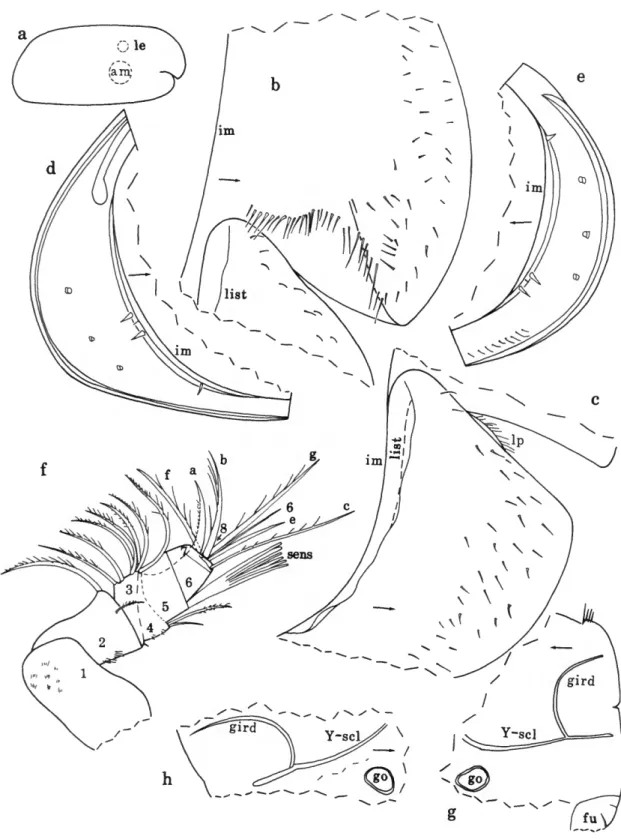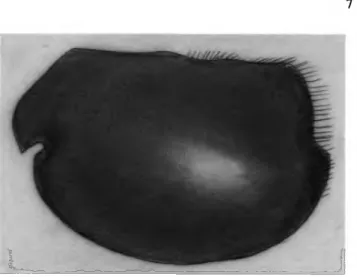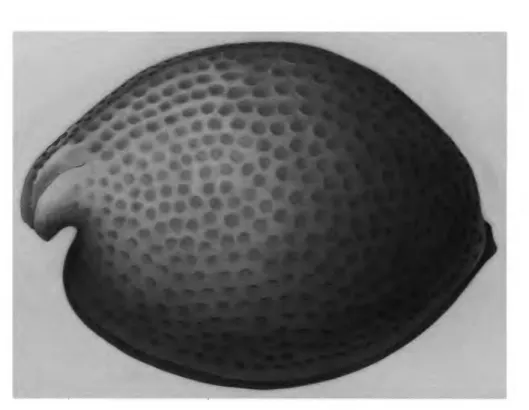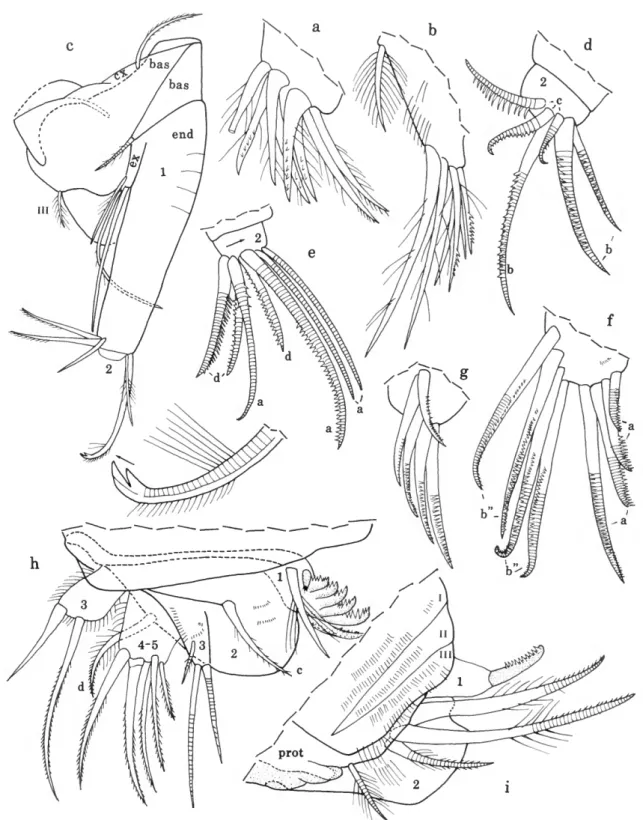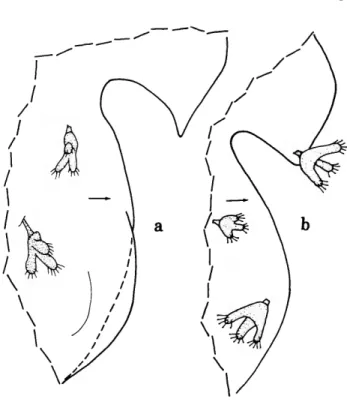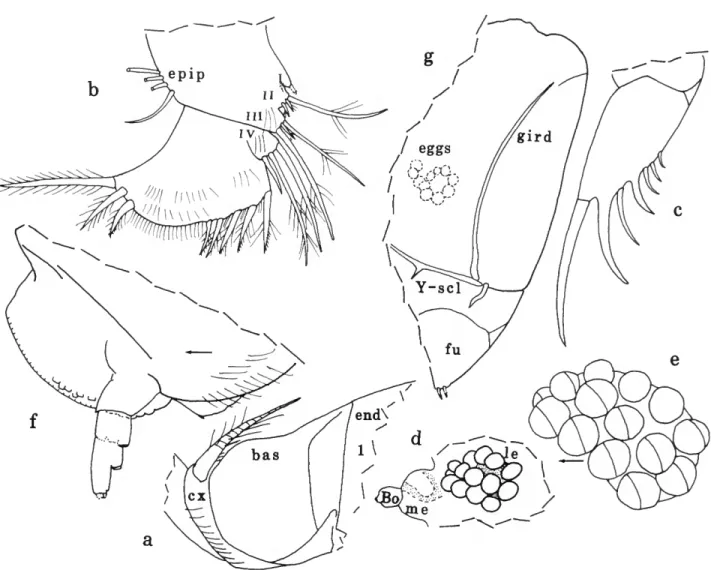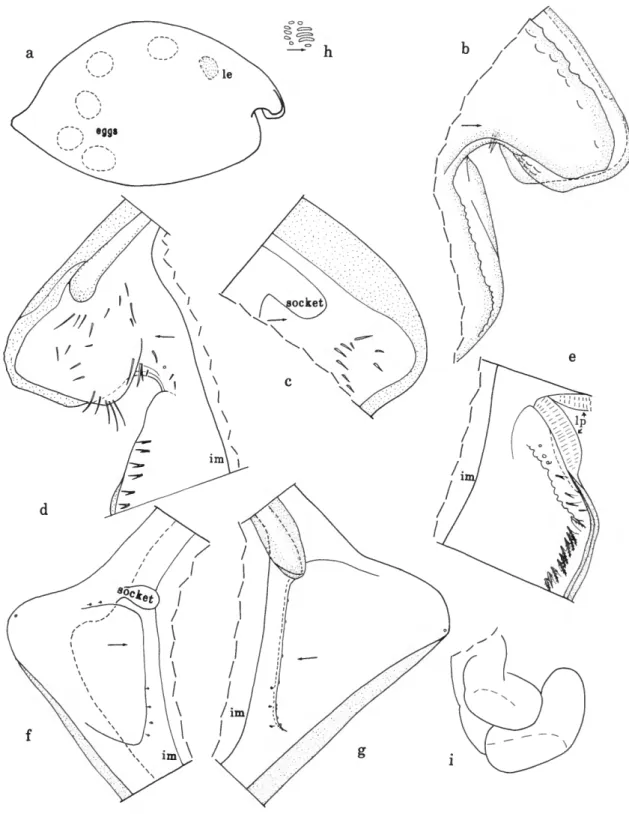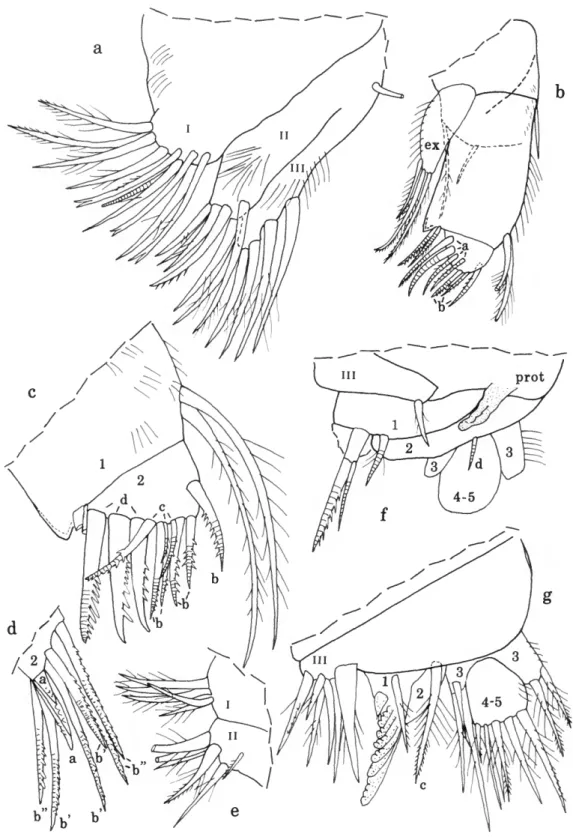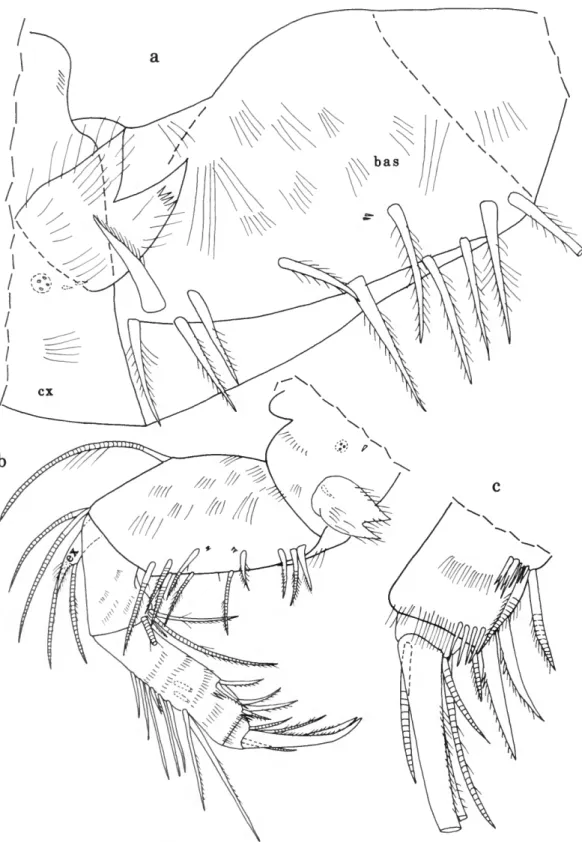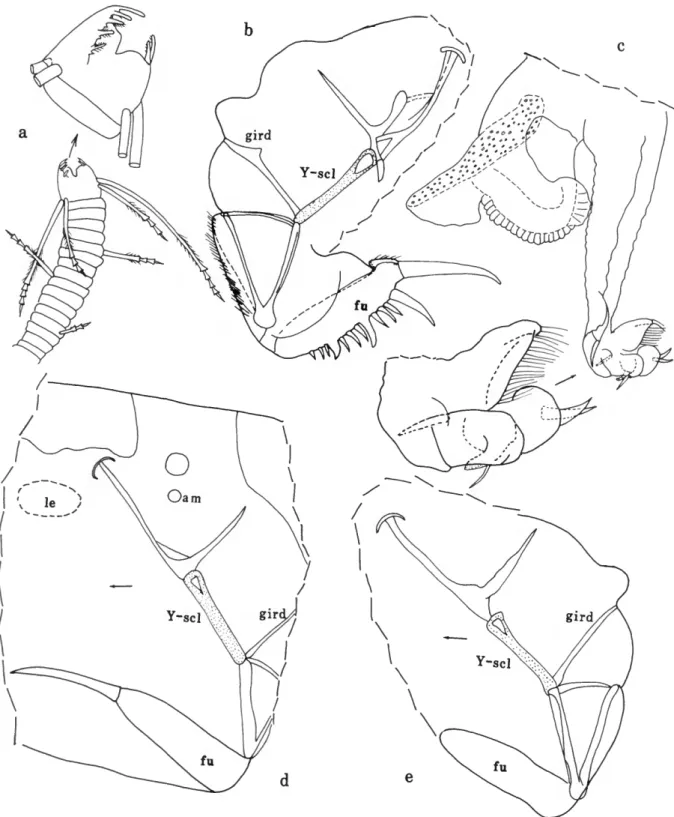1st endopodial joint with 4 ventral bristles (1 short bare medially, 1 medium slender with short spines, 2 long stout with whorls of long spines and small spines distal to whorls). 2nd endopodial joint with 4 a-bristles (3rd pectinate and longest, 4th with indistinct hairs, others exposed) (Figure 8/i), 3 pectinate-ringed b-bristles (Figure 8/), 3 ringed c-bristles (inner short exposed) , others longer pectinate, intermediate bristles with proximal end slightly bulbous) (Figure 8/), and 3 stout pectinate d-bristles (posterior ringed, others urinated) (Figure Sh). 1st endopodial joint with 4 ventral bristles (1 minute just medial, 1 short medial with short spines, 2 long stout with short and long spines).
First endopodial joint with 2 ringed alpha hairs (1 long hair glabrous except for long hairs near hooked tip (with or without small tooth near hooked tip), 1 shorter with long proximal spines) and 3 ringed beta hairs (inner seta short thin glabrous, 2 outer hairs stronger and longer and with bent marginal teeth) (Figure 12/). 2nd endopodial joint with 4 hairs a (3rd from anterior pectinate, others glabrous) (Figure 12/), 3 hairs b with pectinate rings, 3 hairs c with rings (inside short glabrous, others with long curved teeth) and 3 strong d pectinate hairs (posterior with rings, others without rings) (Figure 2, joint with posterior spines with short spines (Figure 13a), anterior spine with hairs long proximal ones (Figure \3c,d), 4 pectinate ringed a- hairs (Figure 13a) (longest ablation may be a hair b'), 5 haired b'-ringed pectinates (Figure 13e) and 4 bristle b' (3 with very large teeth and mostly ringless) (Figure 13 /).
1st endopodial joint with 2 ringed alpha bristles (1 long glabrous, except long bristles near the hooked tip, and with a small tooth proximal to the hooked tip (detail in Figure 18c); 1 shorter with proximal spines) and 3 ringed beta bristles (inner bristles short glabrous, 2 outer bristles with recurved marginal teeth). 2nd endopodial joint with 4 a-bristles (3rd from the anterior pectinate along the posterior margin, 4th with 3 indistinct proximal anterior spines, other more slender glabrous) (Figure 18e), 3 pectinate-ringed b-bristles (Figure 18*/), 3 pectinate ringed c bristles (middle bristles with slightly bulbous proximal end) (Figure 18a"), and 3 stout ringed pectinate D bristles (Figure 18e). Rings of bristles are not always shown). 2nd endopodial joint with 4 ringed bare a bristles (Figure 23c), 3 pectinate b bristles (outer ringed, other unringed), 3 c bristles (2 firm pectinate, 1 minute ringed bare medially) and 3 firm pectinate d bristles (outer distally ringed, other unringed) (Figure 23d).
Terminal compound with 20 bristles (3 short slender bristles (with short marginal spines) near the anterior end, 14 longer and thicker bristles with long proximal and short distal spines, followed by 3 longer plump bristles). 6th joint with short medial bristles (with small, widely separated marginal spines) near the dorsal margin. 1st endopodial joint with 4 ventral setae (1 long with long spines, 1 long with short spines, 1 short with short spines, 1 minute glabrous).
2nd endopodial joint with 4 a bristles (2 anterior with few proximal spines, 3rd glabrous, 4th pectinate) (Figure 34b), 5 pectinate b bristles (Figure 34c; only 3 shown in Figure 34b), 3 pectinate c bristles ( Figure 34c); and 3 coarse pectinate D bristles (outer ones with rings in the distal half) (Figure 34c). 2nd endopodial joint with 3 a-bristles (not shown), 3 unringed pectinate claws and 4 ringed spiny or pectinate bristles (Figure 39c). 3rd endopodial joint with 2 stout claws (with slender ventral teeth except near the tip, and either annulated or weakly annulated) of equal length, 1 short, unringed dorsal claw with upward-pointing tip, and 3 annulated setae (bare or with indistinct spines ).
1st endopodial joint with 3 ventral hairs (2 long with whorls of long spines, 1 short with small spines). 3rd endopodial joint with 3 unringed claws (dorsal claws few and indistinct; large claws with few ventral spines) and 3 ringed hairs). End joint with 6 hairs (anterior 3 with short marginal spines, next with long proximal and short distal spines, posterior 2 plumes). Rings not shown on hair.).
3rd endopodial joint with sturdy terminal claw (sturdier than the claw of the 2nd joint) and 2 small spiny bristles (1 ventral, 1 dorsal).
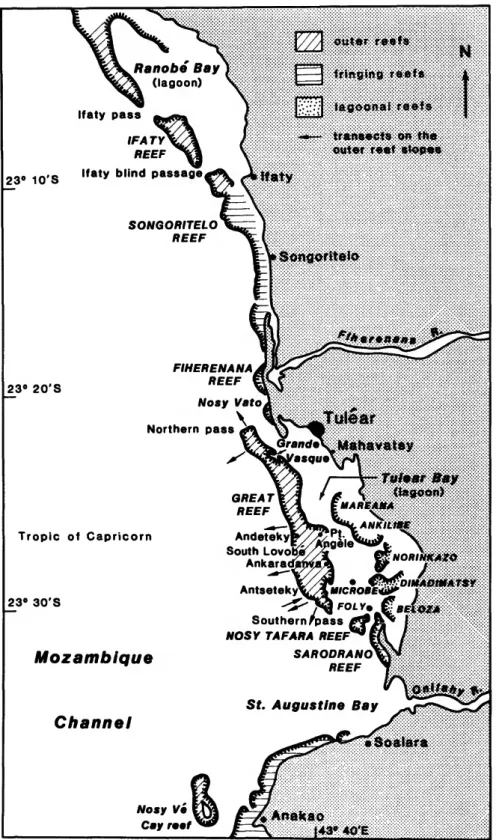
Sclerite and Gills: Similar to those of adult female
2nd endopodial joint: ventral margin with bristles similar to those of adult female (Figure 80b); dorsal medulla with a, b, c and d bristles similar to those of adult female, 3 short bristles proximal to a bristles, 14 spine-shaped cleaning bristles forming 2 or 3 oblique rows between b and d bristles, 1 long spinous medial g-bristle just distal to d-bristle and 1 long slender lateral f-bristle between c- and d-bristles; medial surface with rows of short spines. Furca (Figure 80c): Each lamella with 9 claws followed by small projections with small spines; claws with short slender teeth along posterior margins and small distal spines along anterior margins; right lamella anterior to left at width of base of claw 1. Furca without 2 bristle-like posterior claws on adult female.).
TYPE LOCALITY.-BT-23 1
The dorsal margin of the 2nd endopodial joint of the mandible also bears three or four small proximal spines, which are not reported in other species of the genus. Members were gathered in the Virgin Islands, the West Indies, along the Atlantic coast of North America, near the Kei Islands in Indonesia, Enewetak Atoll in the Pacific, and in the northern part of the Mozambique Channel. REMARKS.—USNM 194203 is interpreted as an A - l stage because of the tapered setae of leg 7 and because each setae has one bell less than the corresponding adult setae.
BT-691: 29 April 1972; Grand Recif, Angela Point area; ridge; an area of bare tumulus sand on top of a sand accumulation populated by seagrass beds; SC (shovel). BT-777A: 7 June 1972; Grand Recife; Grand Vasque (enclosed lagoon); steep inner slope on the side of the outer front of the ridge;. Monograph of the Marine and Freshwater Ostracoda of the North Atlantic and Northwest Europe.
Comparison of Myodocopid Ostracodes in Two Zones of the Belize Barrier Reef near Carrie Bow Cay with Changes in Distribution. Sarsiellidae of the western Atlantic and northern Gulf of Mexico and revision of the Sarsiellinae (Ostracoda: Myodocopina). Requests for special treatment - use of color, fold-outs, case-bound covers, etc. - require, on the same form, an added approval from the sponsoring authority.
The first page of the text should have the title and author at the top of the page; The second page should have only the author's name and professional mailing address, to be used as an unnumbered footnote on the first page of the printed text. Synonymy in zoology should use the short form (taxon, author, annual page), with the full reference at the end of the paper under. Extensive notes should be collected together and placed at the end of the text in a notes section.
For titles of books and articles, use sentence-style capitalization according to the rules of the language used (exception: capitalize all main words in English). Legends for illustrations should be submitted at the end of the manuscript, with as many legends typed, double-spaced, on the page as appropriate. The use of the metric system of measurement is preferred; where the use of the English system is unavoidable, give the metric equivalents in brackets.
